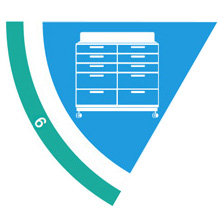
When you read the title of this article, I imagine you had much the same reaction as I did. You must have thought that hygiene habits in the Wild West must be practically non-existent! Indeed, it is difficult to imagine the hygiene habits in the Wild West when we are currently living with COVID-19.
BRIEF HISTORY AND SETTLEMENT OF THE WILD WEST
The Wild West is the most famous period in the history of the American West. This period began in 1865 after the Civil War (between 1861 and 1865) and ended in 1895. Geographically speaking, the Wild West constitutes the territories located in the west of the Mississippi. Of course, there had been several waves of settlement in the West since the arrival of the first European settlers in America. The California Gold Rush of the 1840s was the first, and the call of Manifest Destiny (the idea that westward expansion was an American right and should be guaranteed) was the second. With the development of railroads in the 1860s and improved technology after the Civil War, the west became more accessible.
THE PRESENCE OF SOAP AND SHAMPOO
According to Frank Clifford, a cowboy and drifter who wrote a memoir about his life in the American Wild West, soap existed. He spoke of “soap-weed,” which Mexican women used to wash their hair. Made from the yucca plant, the soap left hair soft, clean and shiny. Many settlers used soap made from animal fat, although it was known to be harsh and irritate the skin. However, soap was not a priority. Body odor was considered a fact of life and many believed that having pores that were too clean exposed them to germs and disease.
As for shampoo, some people used soap-weed to wash their hair when they were lucky enough to have it. Another method was the use of whiskey, which was also used as a disinfectant. It was mixed with castor oil to wash the hair, which was then rinsed with rainwater or water softened with borax.
THE INEVITABLE DUST
Outside and inside, dust was inevitable in the Wild West. Frequent and devastating, dust storms covered entire towns with thick layers of dirt and grime. Sarah Raymond Herndon, author of American stories who traveled from Missouri to the Montana area in the 1860s, quotes: “Oh, the dust, the dust; it is terrible. I have never seen it half as bad; it seems to be almost knee-deep in places […] When we stopped, the boys’ faces were a sight; they were covered with all the dust that could stick on.” The presence of so much dust, of course, caused severe respiratory illness.
THE USEFULNESS OF THE SCARF
The scarf, one of the iconic aspects of cowboy attire, was an essential and used for a multitude of purposes. It was used to protect the mouth and nose from dust (like a mask), to protect the neck from the sun, the ears from the cold and much more.
COMMON TOWELS IN SALOONS

Towels in Wild West bars were used to wipe beer foam from customers’ mouths and beards. These shared towels were accessible to everyone near the bar counters. They were thus carriers of innumerable germs and diseases.
THE OUTHOUSES, A NIGHTMARE

The outhouses experience is, going into a shed built over a hole in the ground. When the hole was full, it was buried. Then, the structure would be moved to another hole. Outhouses attracted all kinds of insects because of the smell. These toilets were an easy way to catch diseases. There was no toilet paper, so people used leaves, corncobs and grass.
NOT BEING ILL WAS A MIRACLE

Eventually, due to the unsanitary conditions of the many people living in the Wild West, it was normal for diseases to affect the settlements on the American frontier. Cholera was one of the most important and was devastating to both settlers and Native Americans. Upon arrival at one camp, Sarah Raymond Herndon said, “There is no disease at all in the camp; it is wonderful how well we are doing. I hope it continues that way.”
So, it’s no surprise that the hygiene habits of that era were terrible.
To learn more about the history and other facts of the Wild West, visit the sources below.
Loose translation of What Was Hygiene Like In The Wild West?
Sources :
https://www.bavardist.com/life/habitudes-dhygiene-dans-le-far-west/3/?chrome=1
https://armoireaquestions.com/bibliotheque/article/read/68981-quel-epoque-far-west
https://the-western-shop.com/blogs/blog-du-western/far-west#:~:text=La%20colonisation%20de%20l’Ouest,s’est%20termin%C3%A9e%20en%201895
https://www.ranker.com/list/hygiene-wild-west/melissa-sartore
https://www.youtube.com/watch?v=nOg00Q08Wek



































